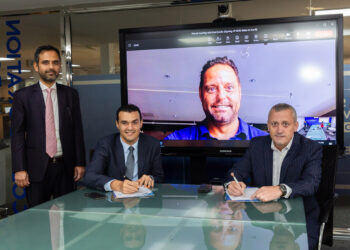
Industry 4.0 — the digital revolution — is changing the way we live, work and interact with our surroundings and each other. The speed we are seeing technological breakthroughs is unprecedented, and the evolution of the facilities management sector is hurtling forward at an exponential rather than linear pace. The Emrill team is often asked what the future of FM will be — will machines replace people? Will decision-making be overtaken by computers? While change is a certainty, we believe the future is now, and we don’t have to look too far ahead to see what impacts these changes will have on the industry. After all, we are already utilising IoT-based service delivery, big data and automation across Emrill’s contracts.
A challenge for every FM provider is doing things better, quicker, more efficiently and at a competitive price. Harnessing, adopting and integrating technology has provided us with a means to achieve just this. Emrill has developed and launched an IoT-based infrastructure management system aimed at empowering employees, providing increased transparency to clients and augmenting quality assurance.
Initially rolled out in a large master community in Dubai, the system offers real-time remote monitoring, making the management of the main pumping system more efficient without requiring a heavy financial investment or major operational system modifications.
Automation has also been incorporated into the system with the installation of critical water quality sensors that can measure algae, turbidity, conductivity and pH levels. With the introduction of a controlled pressure-reducing valves system, automatic alert notifications are triggered when abnormal pressure in the discharge line is detected, reducing the risk of leaks or damage.
Emrill’s IoT-based service delivery has eliminated the need for dedicated pump operators who may be idle for periods, enabling us to optimise manpower on-site without sacrificing quality. The always-live, remote management functionality has enabled us to reduce pipeline leakages and defects by more than 50 per cent, cut downtime and resulting pipeline rectification works, improve aquatic life and have a positive impact on landscaping mortality, reducing collateral damage to asphalt, curbstone and interlocked pathways, across the 1,119-hectare community, including its 48.83-kilometre underground piping system.
This programme has not been limited to the proprietary system we developed. We have also been utilising IoT devices available in the marketplace. For example, we have installed sensor technology on street and community lighting. These sensors detect any disruptions and outages, identifying which sector they have occurred in, and automatically send alerts to our roaming teams of technicians. As a fail-safe, if the alert is not responded to, the system automatically escalates the issue, raising the alarm and calling the responsible supervisor. Once the issue has been resolved, the alarm is automatically deactivated, and the entire process is logged in real-time.
The benefits of automating these processes are two-fold. Firstly, when critical lights experience outages, this poses a health and safety risk to residents. By responding to interruptions immediately, this threat is mitigated. Secondly, access to data has enabled us to enhance our preventative maintenance schedule and proactively resolve issues.
We have judged the success of the integration of IoT-based service delivery and automation based not only on the verifiable, tangible results but also on client satisfaction, as we approach everything we do with client and resident-centricity in mind. By creating end-to-end operational visibility across the entire system and storing control system data and asset parameter logs in the cloud, information and reports are shared seamlessly between site-based employees, supervisors, managers and the client. This, in addition to the system’s contribution to our ability to achieve uninterrupted water supply and cost savings, has improved client and resident satisfaction.
You may also like
-
Suzie Razmjou Radio Interview on Business Breakfast
August 15, 2019 -
Arada awards Emrill three-year facilities management contract
February 11, 2021




